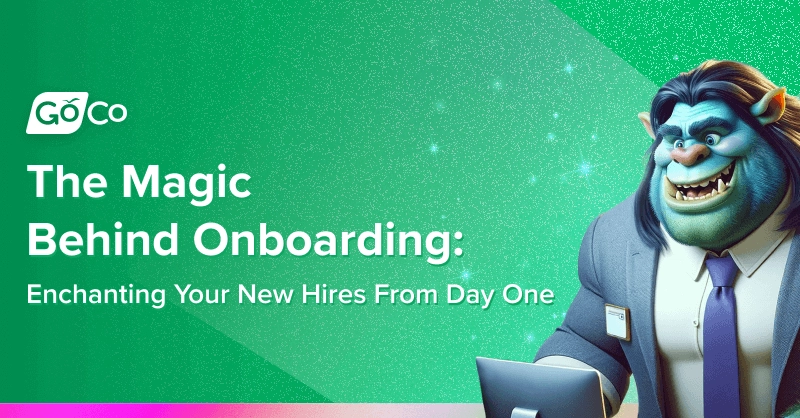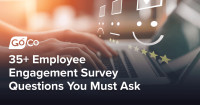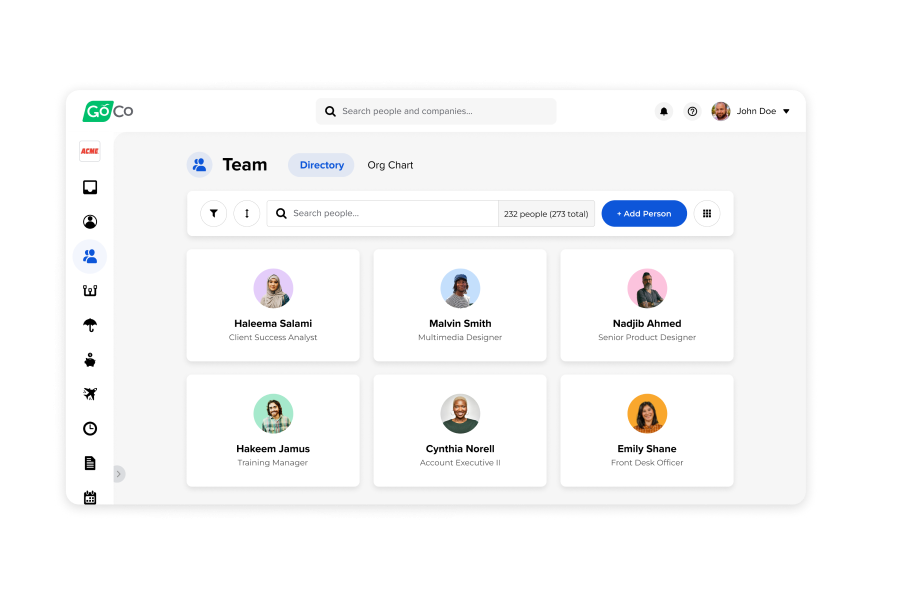The Magic Behind Onboarding: Enchanting Your New Hires From Day One
A panel of HR wizards weigh in on how to make the first day magical for new hires.
by GoCo - March 13th, 2024

Crafting a great first day for your new hires can sometimes feel like trying to slay a many-headed monster. Fear not, because we've curated an expert panel of seasoned HR industry leaders to answer your most challenging onboarding questions, including how to create the best first day and beyond!
Creating a Great First Day
Let us walk you through how these industry leaders onboard their best-in-class teams - from setting everyone up for success on the first day to ensuring they show up for the second day! You'll also learn best practices for common onboarding challenges, such as onboarding remote or international employees, asking for investment, or measuring the success of an onboarding process. Our experts include:
Maureen Adams, Independent HR Consultant. Adams manages SMB client relationships - with a combined employee base of more than 3,000 employees worldwide. Before her career as an independent consultant, she was an HR leader at Microsoft Corporation from 2005 to 2012. She has a BA from the University of Waterloo.
Corey Berkey, JazzHR's former Human Resources Director, holds an SHRM-SCP and has been in HR for over ten years. He specializes in early-stage companies and tech. He has a B.Sc in Human Resources Management from Indiana University of Pennsylvania.
Sarah Koller, GoCo's former People Operations Specialist, holds a BA from Miami University and a B.Sc in Computer and Information Systems.
Before the First Day
Onboarding, particularly the work that happens before the first day, plays a crucial role in shaping the first impression new hires form about your company. To create the perfect onboarding experience, your organization must begin the onboarding process before the first day.
Personalizing the experience is important. Knowing who the person is. Where did they come from? What are their values? What are their beliefs? How do they align with your organization's beliefs?

The role of the human resources team is to quarterback the onboarding process. Still, the team involved is much more comprehensive as it can truly take a village to onboard a new hire: the hiring manager, the new hire buddy, the team, IT, operations, and so on.
As the HR team, you'll need to coach and prepare each person for their role in the onboarding process. One of the most significant onboarding pain points we identified in the webinar is coordinating with other team members, so take the time to explain to each of them why onboarding is so important and how it can impact success, retention, and the overall experience of the new hire.
You'll need to complete practical tasks before the first day, such as setting up the new employee's physical space. You can use this opportunity to personalize their onboarding experience—try to integrate what you know about them into their onboarding experience! Your goal is to have "everything at your new hire's fingertips without them having to ask for it.

You can also help your new hire feel welcome and ready when they show up for their first day.
Remember that, while you've done this over 100x in a year, that experience still needs to be personalized for that person. A system can automate a lot of the basic stuff so that you can make the touch points very genuine.

An automated feature, like GoCo's Slack integration, can make it simple to announce the new team member to the broader team or department so they can welcome your new hire on their first day.
Ask the new hire to sign their paperwork in advance so they can focus on meeting the team instead of finding their social security number. You can use an HRMS platform to send their onboarding documents early, allowing them to complete the paperwork from home. This can enable them to ramp up before they even start!
On the First Day
On the first day, you can remind your new hire why they chose your organization and let them know you're excited to have them join. We highly recommend you look for opportunities to personalize the onboarding process whenever possible.
Your goal for the first day should be to make sure they show up for the second day.

Think about the experience you are creating and how you can make it seamless. Imagine this – they sit at their desk, and what's there? The desk is set up, but it's not just a desk and a laptop. We want their swag waiting and laptop set up with their accounts already.
The more you invest in the new hire, the more output you'll get in the long run. The longer you invest during the onboarding process, the longer the employee will stay.

Ensure the day is manageable by focusing your training on digestible information. Day One sets the stage for Week One and Month One. The first-day training plan should be customized for each company, but here's the advice from our panel of experts on what to include to set everyone up for success:
Share your organization's history, values, cultural mentality, and social norms. You can use storytelling to share your organization's history, values, and culture. These powerful messages can inspire your new hire to feel a sense of belonging in your organization. We'll explore the importance of integrating culture into the onboarding process later!
Schedule time for the new hire to hear from a senior leader. This may be possible for smaller companies in person, but for larger companies, it can be a pre-recorded video. This message should inspire employees to align with the organization's mission and purpose. Senior leadership can define an organization, and introducing your new hires to them early is critical to their understanding of the company's culture and values.
Assign tasks to others in the organization. This means your new hire can hear more voices on the first day instead of spending it with the HR team! Through our poll in the webinar, we learned that coordinating with other teams is one of the most complex parts of onboarding for HR. By utilizing technology to automate pieces of the onboarding process, you can reduce the burden on the HR team and create a seamless experience.
Introduce the new hire to their support system: hiring manager, onboarding buddy, IT, operations, and so on. You'll want them to know where to go when they need help or have questions they may feel uncomfortable asking HR or their new boss.
Protip from Corey: Ensure the support system under the new hire is obvious. This is a significant and essential step in onboarding!
Protip from Maureen: Choose an onboarding buddy or mentor with something in common with the new hire to further personalize the onboarding experience (e.g., are they a single mom like me? Do they have a similar role? Did they also relocate for this role?).
From a practical standpoint, spend time on systems. You'll need to ensure their laptop is set up, all their accounts are logged in, and they can start doing their job immediately. This is important so they can do everything in their "post-first day" training plan.
Pair the new hire with someone in a similar role to them so they can experience "a day in the life." They aim to learn their team's core functions and learn more about how their team works together. At this point, they are saturated with knowledge. We want them to feel satisfied with their learning and excited to return the next day.
The last thing most people want to do is spend time in a conference room with HR talking about handbooks and benefits. At the end of the day, you don't want compliance and HR to be the first day's focus.
How can technology support the hiring and onboarding process?
GoCo is an HR software that allows you to focus on the people, not the paperwork. You don't want to welcome new hires with a big stack of paperwork, and as a hiring manager, GoCo can be a game changer to allow new hires to focus their first day on getting to know the company and their coworkers, rather than paperwork.
You can utilize technology to allow your new hire to digitally sign and complete documents all from the comfort of their own home. Doing so will enable them to focus on their team, new role, and the company — not on HR policies. Tasks, such as new hire and onboarding documents, can be automated to complete before their first day. This includes payroll information, health benefits enrollments, non-disclosure agreements, and much more.
You can further automate your HR new hire processes by integrating GoCo with an Applicant Tracking System (ATS), such as JazzHR, so that once someone is marked as "hired," it automatically starts the onboarding tasks. By automating these processes, we can make the hiring and onboarding process seamless and reduce the administrative burden on your HR team. This doesn't just streamline the onboarding process for everyone involved, it elevates your employee's first-day experience! You can explore these features yourself with GoCo's free tour.
Beyond the First Day
Onboarding often focuses on compliance and paperwork — benefits, payroll, retirement, policies, etc. By utilizing HR tech, you can get these tasks out of the way before the employee's first day, allowing you to focus on the more critical aspects of onboarding during the first day, week, month, and beyond.
Focus on Culture
It's crucial to create an onboarding experience that puts culture first, as employees are more successful when they better understand the values and behaviors that make up the company's culture. Changing organizations is tough, and the steepest learning curve is often understanding the social norms and values that underlay every decision.
In the initial week, an upfront commitment to culture can increase engagement and set the new hire up to be productive in navigating the workplace sooner.
Maureen speaks to the importance of "beginning the culture conversation before the first day" and including it in the recruitment process. Before talking about the company's culture, you must know what it is. "Can you articulate the company's culture? Can everyone who works for the organization articulate the company's culture?"
Encourage Connections With Other Teams
Introduce your new hires to others in the organization who are outside of their immediate team. For example, set up a time for your new salesperson to meet someone on the product team. They won't walk away as an expert in Product, but they will have a deeper understanding of the organization and how each business unit contributes to its success.
It will help them go beyond "What's my role?" to "What is this organization"? This creates greater strategic alignment around the vision of the company.
Send a Survey
Use surveys as an opportunity to learn more about your onboarding process — what works and what doesn't. We recommend that you create a survey and send it to new hires after the onboarding process. Their insights can improve the onboarding experience for future new hires.
Onboarding Challenges
We've compiled a Q&A section about the most common onboarding challenges answered by our expert panelists.
How do you convince management to invest in improving the onboarding experience?
A small to medium-sized company feels the impact of a lost employee across the organization. This makes the case for onboarding much easier as we can tie the investment in onboarding into retention and engagement. For larger companies, we are in a state where it's difficult to hire top talent.
Onboarding is not a sexy topic. Still, if you can connect it to the bottom line and establish a sense of urgency by communicating what it costs to hire and train a new employee, you'll have more success convincing others to invest in onboarding. You'll need a team to build a business case for onboarding. And remember to celebrate short-term wins — success won't happen overnight.
How do you measure the success or failure of your onboarding process?
You have to prepare to get feedback from your new hires.

You can utilize metrics to measure the success or failure of your onboarding process. You can measure productivity in some roles, but this only works for some functions or organizations. Another way to measure is by surveying your newly hired employees at the 30, 60, 90, or 180-day markers. You can also review retention rates at those markers and utilize tools to automate this process.
What can we learn from the mistakes of companies with poor onboarding?
The biggest mistake we see is underutilizing the first day. Too often, companies take an excited employee and put them in a conference room to fill out paperwork and read policies on the first morning.
It should be exciting for them! It doesn't have to be so paperwork intensive.

How do you onboard remote or international employees?
Onboarding will look different for every employee. You'll need to consider if they are remote, international, or relocated for this role. Our webinar showed that many of you are responsible for onboarding remote, international, out-of-state, or field employees.
You'll need to create additional support systems for employees in these situations; for example, introduce remote employees to other remote employees or in the same country. If they've relocated themselves or their families for the job, make sure they have a support system to land well in their role but also in their new city.
Remote onboarding doesn't have to be remote — we recommend bringing the employee on-site for the first day if possible. However, it's not always possible to get someone on-site, or sometimes the team is 100% remote. In those situations, you can utilize a self-guided onboarding experience with a tool like GoCo, so everything is in one place, and they don't need to go to multiple tools.
Final Thoughts
At GoCo, we're committed to creating a great onboarding experience for new hires. Our mission is to make business operations accessible and empower companies to care for their employees.
Our panel of experts outlined how you can create a great first day while utilizing software solutions to automate the compliance aspects of onboarding. Are you interested in elevating your company's onboarding experience? Take GoCo for a spin with a free tour.
Recommended Posts
New Hire Paperwork & Onboarding Forms 2025
Blog Articles
Search...
Product
GoCo
Resources
Articles
eBooks
Webinars
Customer Stories







